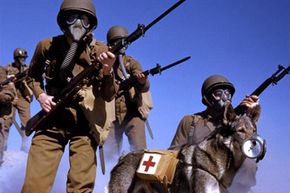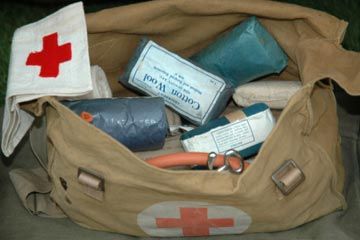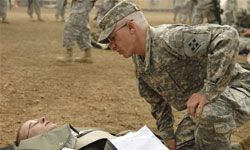Ever since humankind has learned to batter the body through warfare, we've striven to mend it with medical care. In fact, the battlefield has served as a laboratory in which new medical techniques and advances have been formed throughout the ages. Chief among these is the concept of first aid -- medical assistance rendered to a wounded person as close to the time of damage as possible.
The history of first aid in the United States Army begins with the conflict that formed our country: the Revolutionary War.
Advertisement
When the battle for American independence began in 1775, the level of health care in the New World was generally poor. Although there were approximately 3,500 people who called themselves physicians in the colonies, only about 200 of them actually held medical licenses [source: McCallum]. This isn't surprising considering that the first medical college at the University of Pennsylvania had opened just 10 years earlier.
If caring for the public wasn't a priority, caring for the soldiers fighting for a new homeland was even less so. This was perhaps most clearly shown by the actions of General Horatio Gates who, after the Battle of Bunker Hill, left his wounded men on the field for up to three days, causing many of them to die. Of the men who were saved, many were forced to pay outrageously high fees to stay at convalescing quarters.
These conditions led the Massachusetts Provincial Congress to mandate the establishment of military hospitals and require that one surgeon and two surgeon's mates would serve with the colonel of each regiment in the field.
Yet in the winter of 1776, men were still dying in droves -- and not necessarily from bayonet strikes. They were falling prey to diseases like pneumonia, dysentery and smallpox. Therefore, General George Washington petitioned the Continental Congress to establish what he called "the Hospital": a general medical corps for soldiers. Begun on July 27, 1775, it was set up to serve an Army of 20,000 with four surgeons, an apothecary, 20 surgeon's mates, one clerk, a storekeeper and one nurse for every 10 patients [source: McCallum]. It was the first national medical military organization ever established in the newly forming country.
Despite this, care remained poor. A full 10 percent of all soldiers who fought on the American side of the war died -- 6,500 of them on the battlefield, 10,000 in the hospital [source: McCallum].
So how did Army first aid improve over the years? Keep reading to find out.
Advertisement



